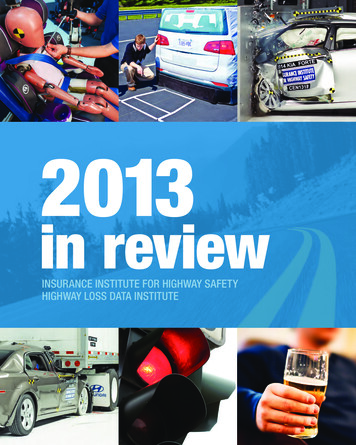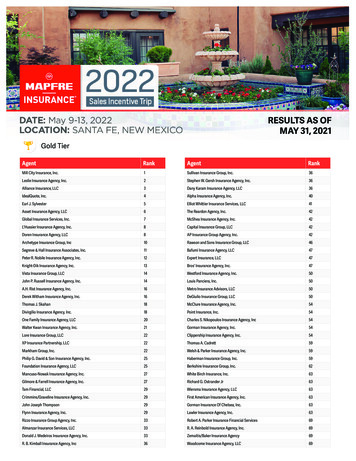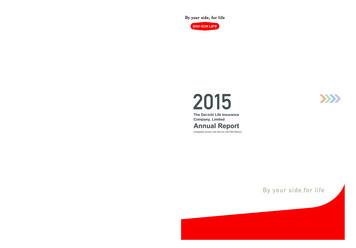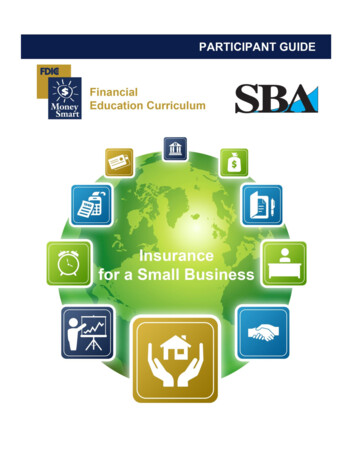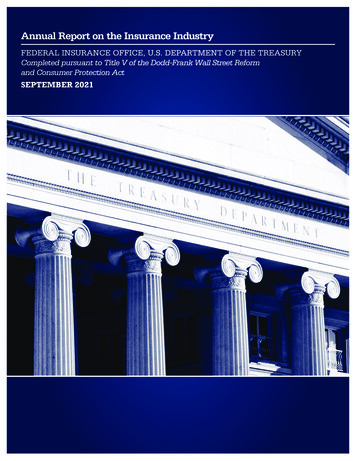
Transcription
Annual Report on the Insurance IndustryFEDERAL INSURANCE OFFICE, U.S. DEPARTMENT OF THE TREASURYCompleted pursuant to Title V of the Dodd-Frank Wall Street Reformand Consumer Protection ActSEPTEMBER 2021
Annual Report on the Insurance Industry (September 2021)TABLE OF CONTENTSEXECUTIVE SUMMARY . VIIII. INTRODUCTION. 1Federal Insurance Office Authorities and Insurance Regulation . 1The Structure of this Report . 3II. INSURANCE INDUSTRY FINANCIAL OVERVIEW AND OUTLOOK . 4Domestic Insurance Marketplace Overview and Outlook . 4Financial Performance and Condition Overview . 5Life and Health Sector . 9Box 1: Registered Indexed-Linked Annuities: Addressing Longevity RiskThrough Annuities . 26Property and Casualty Sector . 27Market Performance . 42Domestic Outlook. 44Capital Markets Activity . 46Mergers & Acquisitions of U.S. Insurers . 46Box 2: Life Sector Restructuring . 47Changing Investment Strategies . 48Alternative Risk Transfer Insurance Products. 49Private Equity-Backed Insurers . 50InsurTech Investments . 52International Insurance Marketplace Overview and Outlook . 53III. TOPICAL UPDATES AND FIO ACTIVITIES . 56Pandemic-Related Updates . 56Domestic . 57International. 63Climate Change, Mitigation, and Resilience. 641. Climate-Related Risks and Catastrophic Events . 64Box 3: Residual Markets . 662. Responding to Climate-Related Executive Orders . 673. Mitigation and the Mitigation Framework Leadership Group . 694. National Flood Insurance Program. 705. State Climate-Related Efforts and Response to Catastrophic Events . 706. International Work . 73Cyber Risks, Ransomware, and Cyber Insurance . 74The Cyber Insurance Market and Ransomware’s Impact . 74The Threat of Ransomware . 77U.S. Cybersecurity and Ransomware Responses . 78FEDERAL INSURANCE OFFICE, U.S. DEPARTMENT OF THE TREASURYi
Annual Report on the Insurance Industry (September 2021)Terrorism Risk Insurance Program . 80TRIP Data Collection . 81Small Insurer Study . 82FIO Advisory Committees . 83Advisory Committee on Risk-Sharing Mechanisms . 83Federal Advisory Committee on Insurance . 83Box 4: Initiatives on Diversity and Inclusion . 85Personal Auto Insurance . 86Background . 87FIO’s Current Work on Auto Insurance . 90Box 5: The Use of Credit Scores in Insurance Underwriting . 90InsurTech. 91Long-Term Care Insurance . 93Financial Stability Oversight Council . 95State Initiatives on Systemic Risk and Solvency . 96Macroprudential Initiative and Liquidity Stress Testing Framework . 97Group Capital Calculation . 98Box 6: Risk-Based Capital for Bonds and Real Estate . 99International Developments . 100IAIS . 100Covered Agreements . 106Additional International Engagements . 111IV. CONCLUSION . 114FEDERAL INSURANCE OFFICE, U.S. DEPARTMENT OF THE TREASURYii
Annual Report on the Insurance Industry (September 2021)GLOSSARY2020 Annual Report2021 Small egation Method.ARTCISAClimate-Related RFI.CLOCMBSComFrameDodd-Frank Act.EIOPAExCoFACIFAIR PlanFederal ReserveFEMAFIFFIOFIO ActFSBFSOCFSTFGAOGCCGDPGIMAR.FIO, Annual Report on the Insurance Industry (2020)FIO, Study of Small Insurer Competitiveness in the TerrorismRisk Insurance Marketplace (2021)Access to Insurance InitiativeNAIC Financial Regulation Standards and AccreditationCommitteeAdvisory Committee on Risk-Sharing MechanismsAccident and HealthA group capital methodology under development by theUnited States and other interested jurisdictions as analternative to the ICSAlternative Risk TransferCybersecurity and Infrastructure Security AgencyFederal Insurance Office Request for Information on theInsurance Sector and Climate-Related Financial Risks, 86Fed. Reg. 48814 (August 31, 2021)Collateralized Loan ObligationCommercial Mortgage-Backed SecuritiesIAIS Common Framework for the Supervision of IAIGsDodd-Frank Wall Street Reform and Consumer ProtectionAct of 2010European Insurance and Occupational Pensions AuthorityIAIS Executive CommitteeFederal Advisory Committee on InsuranceFair Access to Insurance Requirements PlanBoard of Governors of the Federal Reserve SystemFederal Emergency Management AgencyIAIS Financial Inclusion ForumFederal Insurance OfficeFederal Insurance Office Act of 2010Financial Stability BoardFinancial Stability Oversight CouncilNAIC Financial Stability Task ForceU.S. Government Accountability OfficeGroup Capital CalculationGross Domestic ProductIAIS Global Insurance Market ReportFEDERAL INSURANCE OFFICE, U.S. DEPARTMENT OF THE TREASURYiii
Annual Report on the Insurance Industry (September 2021)GMEHealth sector.Holistic PPCITFL&HLST ECDORSAP&CPCRPERBCReportRILA.IAIS Global Monitoring Exercise for the Holistic FrameworkHealth sector includes companies licensed solely as healthinsurers or as health maintenance organizationsIAIS Holistic Framework for the Assessment and Mitigationof Systemic Risk in the Insurance SectorInternationally Active Insurance GroupInternational Association of Insurance SupervisorsInsurance Institute for Business & Home SafetyIAIS Insurance Core PrincipleIAIS Insurance Capital StandardInsurance-Linked SecuritiesInsurance Marketplace Aggregate Retention AmountThe innovative use of technology in connection withinsuranceInitial Public OfferingOECD Insurance and Private Pensions CommitteeIAIS Infrastructure Task ForceLife and HealthNAIC Liquidity Stress Testing FrameworkLong-Term Care InsuranceMergers and AcquisitionsMitigation Framework Leadership GroupNational Association of Insurance CommissionersNuclear, Biological, Chemical, and RadiologicalNational Council of Insurance LegislatorsNational Flood Insurance ProgramCentral Banks and Supervisors Network for Greening theFinancial SystemNew York Department of Financial ServicesOrganisation for Economic Co-operation and DevelopmentOwn Risk Solvency AssessmentProperty and CasualtyPrescribed Capital RequirementPrivate EquityRisk-Based CapitalFIO, Annual Report on the Insurance Industry (2021)Registered Index-Linked AnnuityFEDERAL INSURANCE OFFICE, U.S. DEPARTMENT OF THE TREASURYiv
Annual Report on the Insurance Industry (September 2021)S&P GlobalSECSecretarySIFSMITeam USATreasuryTRIATRIPU.S.-EU CoveredAgreement.U.S.-UK CoveredAgreement.S&P Global Market IntelligenceU.S. Securities and Exchange CommissionSecretary of the TreasurySustainable Insurance ForumSolvency Modernization InitiativeFIO, Federal Reserve, NAIC, and state insurance regulatorsU.S. Department of the TreasuryTerrorism Risk Insurance Act of 2002, as amendedTerrorism Risk Insurance ProgramBilateral Agreement between the United States of Americaand the European Union on Prudential Measures RegardingInsurance and ReinsuranceBilateral Agreement between the United States of Americaand the United Kingdom on Prudential Measures RegardingInsurance and ReinsuranceFEDERAL INSURANCE OFFICE, U.S. DEPARTMENT OF THE TREASURYv
Annual Report on the Insurance Industry (September 2021)TABLE OF FIGURESFigure 1: Total Direct Premiums Written for L&H and P&C Sectors .5Figure 2: L&H Insurance Groups by 2020 U.S. Life Insurance Lines DirectPremiums Written.6Figure 3: L&H Insurance Groups by 2020 U.S. A&H Lines Direct PremiumsWritten .7Figure 4: P&C Insurance Groups by 2020 U.S. Combined Lines Direct PremiumsWritten .8Figure 5: Health Insurance Groups by 2020 U.S. Health Lines Direct PremiumsWritten .8Figure 6: L&H Sector Net Premiums, Considerations, and Deposits .10Figure 7: 2020 Composition of Net Premiums and Annuity Considerations for theL&H Sector .10Figure 8: L&H Sector Expenses .11Figure 9: L&H Sector Annual Net Investment Income ( thousands) and NetYield on Invested Assets .12Figure 10: Percentage Yield on 10-Year Treasury Bonds .13Figure 11: L&H Sector Net Income ( thousands) .14Figure 12: L&H Sector Operating Ratios.14Figure 13: L&H Capital and Surplus Position ( thousands) .15Figure 14: Leading Determinants of Capital and Surplus for the L&H Sector .16Figure 15: Average Risk-Based Capital Ratio for the L&H Sector .17Figure 16: L&H Sector Leverage Ratios .18Figure 17: Composition of L&H Sector General Account Assets and InvestmentPortfolio .20Figure 18: Cash Flows from Operations for the L&H Sector .21Figure 19: A View of L&H Sector Liquidity .23Figure 20: Variable Annuity and RILA Sales ( billions) .27Figure 21: P&C Sector Composite of Direct Premiums Written .28Figure 22: P&C Sector Direct Premiums Written .29Figure 23: P&C Sector Combined Operating Ratios .29Figure 24: Estimated Insured Property Losses, U.S. Catastrophic Events.30Figure 25: Total One Year Reserve Development for the P&C Sector ( billions) .31Figure 26: P&C Sector Annual Net Investment Income ( billions) and NetYield on Invested Assets (%) .32Figure 27: P&C Sector Net Income ( billions) .33FEDERAL INSURANCE OFFICE, U.S. DEPARTMENT OF THE TREASURYvi
Annual Report on the Insurance Industry (September 2021)Figure 28: P&C Sector Operating Ratios (%) .33Figure 29: P&C Sector Leverage Ratios .35Figure 30: Composition of Asset Portfolio for P&C Sector .36Figure 31: Composition of P&C Sector’s Investment Portfolio .37Figure 32: A View of P&C Sector Liquidity .39Figure 33: P&C Sector Structured Securities Holdings .41Figure 34: P&C Sector’s Affiliated Exposures .41Figure 35: Insurance Industry Stock Price vs. S&P 500 .43Figure 36: Insurer Price/Book Value Ratios .44Figure 37: World Market Share 2018 – 2020 for Top Twenty Markets ( millions) .54Figure 38: Performance of Global Insurance Indices as Compared to BroaderMarket Average (S&P 500) .55Figure 39: P&C Insurance Groups by U.S. Cyber Direct Premiums Written .76Figure 40: IAIS Organizational Structure in 2021 .101FEDERAL INSURANCE OFFICE, U.S. DEPARTMENT OF THE TREASURYvii
Annual Report on the Insurance Industry (September 2021)EXECUTIVE SUMMARYIntroduction: This section explains that this Report is submitted by the Federal InsuranceOffice of the U.S. Department of the Treasury pursuant to Section 502(a) of the Dodd-FrankWall Street Reform and Consumer Protection Act. This section also provides a summary ofFederal Insurance Office authorities and contains a roadmap to the Report.Insurance Industry Financial Overview and Outlook: This section provides an overview ofthe insurance industry from a financial perspective in calendar year 2020.Domestic Insurance Marketplace Overview: This section provides an overview of theinsurance industry’s financial performance and condition in 2020. The U.S. insurance industrywas able to maintain its financial health in 2020. The sustained low interest rate environmentcontinues to affect the insurance industry’s performance. Despite the many impacts of theCOVID-19 pandemic, the trend of annual increases in premium continued in 2020.Financial Performance and Condition Overview: This sub-section focuses on thefinancial performance and condition of the 676 life & health insurers, the 2,614 property &casualty insurers, and the 1,260 health insurers licensed in the United States during 2020.Insurers in the Life & Health sector offer products in two segments: (1) life insurance andannuities; and (2) accident and health products. Insurers in the property & casualty sectoroffer products that generally protect against the risk of financial loss associated with damageto property or exposure to liability for individuals, families or businesses. The health sectorincludes companies licensed solely as health insurers or as health maintenanceorganizations, but is not the focus of the remainder of this Report.Direct premiums written in 2020 for the life & health sector were approximately 767billion, for the property & casualty sector were approximately 717 billion, and for thehealth sector were approximately 834 billion. At the end of 2020, the life & health sectorheld approximately 8.0 trillion of total assets, the property & casualty sector heldapproximately 2.4 trillion, and the health sector held approximately 515 billion.The aggregate market shares of the top 10, 25, and 100 Life & Health insurance companiesin 2020 were little changed compared to 2019. For both commercial lines and personallines, there was little change in the aggregate market shares of the top 10, 25, and 100Property & Casualty companies in 2020. The health market continued to tighten somewhatat the top, with the aggregate market share of the top 10 writers increasing nearly one-andone-half percentage points (to 60 percent) from 2019.Life and Health Sector: This sub-section presents additional analysis of the financialperformance of the life & health sector in 2020, and then assesses this sector’s overallfinancial condition as of December 31, 2020.Property and Casualty Sector: This sub-section presents additional analysis of thefinancial performance of the property & casualty sector in 2020, and then assesses thissector’s overall financial condition as of December 31, 2020.FEDERAL INSURANCE OFFICE, U.S. DEPARTMENT OF THE TREASURYviii
Annual Report on the Insurance Industry (September 2021)Market Performance: In 2020, both the property & casualty and the life & health sectorstock indices significantly underperformed the S&P 500. Questions related to the potentialliability for pandemic-related losses such as business interruption claims weighed onproperty & casualty company stocks, while the combination of uncertainty around theseverity of morbidity and mortality experience from the pandemic and the drop in interestrates put downward pressure on life & health insurer stocks.Domestic Outlook: This sub-section provides some insights into near-term trends,reflecting observations from 2020 and the first half of 2021.Capital Markets Activity: This section notes that the U.S. insurance industry continued toaccess the equity market for new capital throughout 2020. During the year, 17 insurance-relatedpublic equity offerings were completed, with an aggregate value of 5.5 billion. Debt marketscontinued to be the preferred source of additional capital for insurers in 2020.Mergers & Acquisitions of U.S. Insurers: This sub-section notes, among other things,there were 95 merger and acquisition transactions announced in 2020 involving U.S.insurers and reinsurers, with a total value of 13.4 billion.Changing Investment Strategies: This sub-section discusses the factors that haveprompted the U.S. insurance industry to deploy new investment strategies in recent years.Alternative Risk Transfer Insurance Products: This sub-section summarizes 2020developments in the alternative risk transfer market—in which the outstanding amount ofcatastrophe bonds and insurance-linked securities instruments was approximately 46billion at the end of 2020—and notes its continuing growth in the first half of 2021.Private Equity-Backed Insurers: This sub-section observes that private equity-owned lifeinsurers have continued to expand rapidly in the U.S. insurance industry and are now someof the largest providers of fixed annuities and pension risk transfers in the sector.InsurTech Investments: This sub-section highlights how InsurTech startups continued toreceive significant investments in 2020.International Insurance Marketplace Overview and Outlook: This section concludes thatthe United States remained the world’s largest single-country insurance market in 2020. Whenviewed as a single market, the combined share of the European Union (following the exit of theUnited Kingdom) was the next largest. China remained the second-largest single-countryinsurance market.Topical Updates and FIO Activities: This section provides updates and analyses, as well asFederal Insurance Office activities, in several areas which the Federal Insurance Office hasanalyzed over the past year.Pandemic-Related Updates: This section updates the Federal Insurance Office’s previouspreliminary observations on the impact of the COVID-19 pandemic on the insurance industry.FEDERAL INSURANCE OFFICE, U.S. DEPARTMENT OF THE TREASURYix
Annual Report on the Insurance Industry (September 2021)Climate Change, Mitigation, and Resilience: This section discusses numerous topics andactivities related to U.S. insurance markets and climate change, mitigation and resilience.Among other things, it notes that U.S. insurance markets will play a vital part in achieving thegoals set forth in two climate-related Executive Orders. The Federal Insurance Officehighlights these Executive Orders, among other things, in its request for information on climaterelated financial risks and the insurance sector, published on August 31, 2021. The request forinformation highlights, among other things, that traditionally underserved communities andconsumers tend to have the least access to affordable insurance products and services and aredisproportionately impacted by climate change. Mitigation and the availability of insurance isalso among the topics addressed in the request for information, as well in this section. Thissection also discusses the National Flood Insurance Program, noting that flooding is one type ofweather-related event that is being exacerbated by climate change. More generally, the sectionnotes how the Federal Insurance Office continues to engage on climate-related issues with stateinsurance regulators and the National Association of Insurance Commissioners to learn moreabout their priorities and ongoing efforts to address climate-related risks. The Federal InsuranceOffice also has engaged on climate-related issues through coordination with internationalorganizations.Cyber Risks, Ransomware, and Cyber Insurance: This section focuses on the interplaybetween ransomware and insurance, including the impact of ransomware on the cyber insurancemarket, and efforts of both federal and state policymakers and regulators to develop responsesto the growing threats of ransomware.Terrorism Risk Insurance Program: This section provides updates on the Terrorism RiskInsurance Program, including its data call and study on small insurers.Advisory Committee on Risk-Sharing Mechanisms: This section provides an update onwork related to the federal advisory committee established by the Terrorism Risk InsuranceProgram Reauthorization Act of 2015, which provides the Federal Insurance Office with adviceand recommendations related to terrorism risk insurance.Federal Advisory Committee on Insurance: This section provides updates on the work of theadvisory committee established to provide the Federal Insurance Office with nonbinding adviceand recommendations and to otherwise assist it in carrying out its duties and authorities.Personal Auto Insurance: This section provides background information on the importance ofauto insurance and highlights the Federal Insurance Office’s ongoing work relating to personalauto insurance, including the availability and affordability of insurance for traditionallyunderserved consumers and communities. It also addresses the response of insurers and stateinsurance regulators to the COVID-19 pandemic in the context of auto insurance.InsurTech: This section discusses how InsurTech innovation trends have remained consistentin recent years with continued growth in investments, an emphasis on distribution andmarketing, additional partnerships between startups and incumbent insurers, and a focus onartificial intelligence. It also discusses regulatory developments involving InsurTech.FEDERAL INSURANCE OFFICE, U.S. DEPARTMENT OF THE TREASURYx
Annual Report on the Insurance Industry (September 2021)Long-Term Care Insurance: This section discusses developments in the private market forlong-term care insurance, in which the number of individual long-term care insurance policiessold peaked in 2002 and has decreased in nearly every year since then. The section alsodiscusses ongoing efforts to address long-term care insurance product and market issues.Financial Stability Oversight Council: This section discusses the involvement of the FederalInsurance Office in the Financial Stability Oversight Council, and Financial Stability OversightCouncil activities over the past year.State Initiatives on Systemic Risk and Solvency: This section discusses how, during the pastyear, the National Association of Insurance Commissioners has advanced (1) itsMacroprudential Initiative through the efforts of its Financial Stability Task Force in connectionwith the development of the Liquidity Stress Testing Framework and (2) the Group CapitalCalculation—the foundation for its capital stress testing regime.International Developments: This section discusses the Federal Insurance Office’s work ininternational contexts.International Association of Insurance Supervisors: This sub-section provides anoverview of the International Association of Insurance Supervisors, the role of the FederalInsurance Office in it, and updates on its work, including with respect to the InsuranceCapital Standard which, after six years of field testing, advanced into a five-year monitoringperiod in 2020.Covered Agreements: This sub-section describes and provides updates on the coveredagreements with the European Union and the United Kingdom.Insurance Dialogue Projects: This sub-section describes and provides updates on theEU-U.S. Insurance Dialogue Project, a collaborative effort among U.S. and European Unioninsurance authorities to increase mutual understanding and enhance cooperation between theUnited States and the European Union in order to promote business opportunities, consumerprotection, and effective supervision, and a similar initiative with the United Kingdom.OECD: This sub-section provides an overview of the Organisation for EconomicCo-operation and Development’s Insurance and Private Pensions Committee and its recentwork.Bilateral Dialogues: This sub-section notes that the Federal Insurance Office engages withits international colleagues not only through multilateral forums like the InternationalAssociation of Insurance Supervisors, but also through additional formal and informalbilateral dialogues.Conclusion: The Report concludes that, in the coming year, the Federal Insurance Office willcontinue to address climate-related financial risks, the affordability and availability of insuranceproducts for traditionally underserved communities and consumers, the role of the insuranceindustry in helping to improve our nation’s cybersecurity, and other relevant developmentsaffecting the U.S. insurance industry, policyholders, and consumers.FEDERAL INSURANCE OFFICE, U.S. DEPARTMENT
the insurance industry from a financial perspective in calendar year 2020. Domestic Insurance Marketplace Overview: This section provides an overview of the insurance industry's financial performance and condition in 2020. The U.S. insurance industry was able to maintain its financial health in 2020. The sustained low interest rate environment







